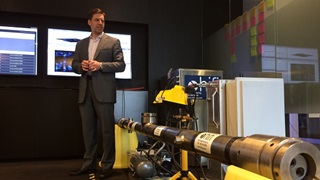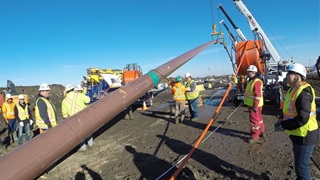Smart Pigs, Safe Pipes (Part 5): An inside job to measure cathodic protection
High-tech tools offer an accurate view of a pipeline’s protective electrical current, coating quality
The best way of testing cathodic protection in a pipeline?
It all starts with some good inside information.
For decades, the energy industry has used cathodic protection, in tandem with robust coatings made of epoxy or coal-tar enamel, to curb corrosion on crude oil and refined product pipelines.
In a nutshell, cathodic protection means turning a pipeline into the cathode of a giant electrochemical battery—applying an external direct electrical current, completing the circuit with “sacrificial” metal rods made of graphite or cast iron, and corroding the sacrificial metal, which becomes the battery’s anode.
Since 2008, Baker Hughes, a GE company, has been the only player in the pipeline inspection industry to use an in-line inspection (ILI) tool to measure that current. The company’s Cathodic Protection Current Measurement (CPCMTM) inspection service collects invaluable (and previously unavailable) cathodic protection (CP) system performance data, with that data telling a definitive story.
“The data that our CPCM tool provides helps a pipeline operator understand why corrosion is taking place at a particular location,” says Dennis Janda, a Houston-based manager of Process and Pipeline Services for BHGE, the world’s premier pipeline inspection service company.
By measuring current magnitude and direction, and identifying current anomalies, the CPCM tool can pinpoint locations where the CP system is being diminished by:
- An insufficient amount of current being applied to the line;
- The adverse influence of an adjacent pipeline’s CP system;
- Physical contact with another pipeline, which is robbing the line’s CP system; or
- Alternating Current (AC)-induced corrosion, an issue in utility corridors that contain high-voltage power lines.
“Our CPCM tool really excels at finding problems an operator might not have even been aware of, and making it easy for the operator to go out and locate, excavate, clear the short, and re-establish that protective current,” says Janda.
Enbridge focuses heavily on prevention to keep our crude oil pipeline network safe. ILI tools—or “smart pigs,” to use industry jargon—are highly complex pieces of machinery that use advanced imaging technology to monitor an entire pipeline for anomalies whose dimensions can be as small as a few millimeters.
BHGE is one of our primary partners in prevention, and Enbridge has entrusted BHGE with robust ILI-based pipeline diagnoses since 1998. In that time, Baker Hughes has performed more than 400 pipeline inspections across Enbridge’s pipeline network, producing more than 70,000 kilometers’ worth of inspection data.
CPCM technology, pioneered almost a decade ago, can reveal pipeline features worthy of a closer look. Often, these features have been missed altogether by conventional data collection methods—all of which require onerous and labor-intensive above-ground surveys, with voltage readings taken as frequently as every three feet along a transmission pipeline.
“We’re measuring every foot of the pipeline as the tool goes through,” says Janda. “We don’t have to skip the areas where it’s difficult to physically access.”
And because the CPCM tool measures current—rather than voltage potential, a byproduct—it can accurately identify spots along a pipeline where the coating requires repair.
“The data will show dramatic change as coating quality changes,” says Janda. “It’s a good way to go find areas that may have coating damage, dig them up, repair and recoat them.”
Check out our previous instalments of the Smart Pigs, Safe Pipes series:
Part 1: Getting down to the finer details
Part 2: New inspection technology doubles down on sensors









